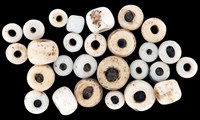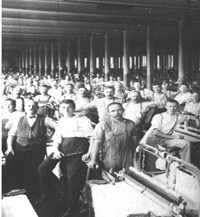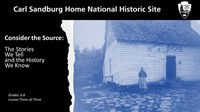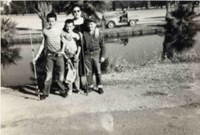- Lesson Plan (676)
- Field Trips (173)
- Distance Learning (150)
- Student Activities (92)
- Traveling Trunk (50)
- Teacher Reference Materials (43)
- Primary Sources (31)
- Guest Speakers (28)
- Other Education Materials (28)
- Media for Loan (6)
- Field Schools & Institutes (5)
- Science Labs (5)
- Teacher Workshops & Other Programs (4)
- Teacher-Ranger-Teacher (1)
- Acadia National Park (57)
- Glacier National Park (35)
- Everglades National Park (29)
- Gateway Arch National Park (27)
- Fort Necessity National Battlefield (22)
- Carl Sandburg Home National Historic Site (20)
- Fort Scott National Historic Site (19)
- Bent's Old Fort National Historic Site (18)
- Haleakalā National Park (18)
- Show More ...
- Social Studies (840)
- Science (490)
- Literacy and Language Arts (380)
- Math (97)
Showing 1,236 results for teaching with primary sources ...
TEACHING WITH PRIMARY SOURCES—MTSU, Lesson Plan: The Trail of Tears
Learning about Mill Workers through Primary Sources
- Type: Lesson Plan
- Grade Levels: Upper Elementary: Third Grade through Fifth Grade
In this lesson, students will examine primary resource documents of mill workers at the Lonsdale Company in 1942. Though these are injury reports, students can get a glimpse into who was working at the mills and what types of jobs they had. Students will compare primary sources to determine similarities and differences among this sample of mill workers.
Primarily Me: Primary Sources from Whitman Mission
- Type: Lesson Plan
- Grade Levels: Upper Elementary: Third Grade through Fifth Grade
What can we learn about the lives of enslaved people from primary sources?
- Type: Primary Sources ... Student Activities ... Teacher Reference Materials
- Grade Levels: Upper Elementary: Third Grade through Fifth Grade
Research Made Real – Using National Park Service Web Pages to Locate Primary Sources
Critical Source Evaluation
- Type: Lesson Plan
- Grade Levels: High School: Ninth Grade through Twelfth Grade
National parks are valuable repositories of information including subject matter experts, photographs, and tangible objects. One of the founding principles of national parks is that this primary source information be preserved so that people may learn from it in the future. Students today may take advantage of this opportunity both in person and online.
Comparing Sources: The Decision to Fight at Cowpens
- Type: Primary Sources
- Grade Levels: Middle School: Sixth Grade through Eighth Grade
Students will use multiple primary sources to build analytical and corroborative skills to examine the circumstances surrounding Daniel Morgan’s decision to fight when and where he chose in the American Revolution.
Why People Move: Introduction to Using Primary Sources (Grades 3-5) Lesson 3 of 3 Carl Sandburg Home NHS
- Type: Lesson Plan
- Grade Levels: Upper Elementary: Third Grade through Fifth Grade
This lesson helps upper elementary students to identify primary and secondary sources and explain how they are used to better understand historical events. It introduces Carl Sandburg and helps students to understand the relevance of the Carl Sandburg Home NHS to the history of the area. Students will learn to differentiate between primary and secondary sources throughout the lesson's activities. This is the 3rd of three lessons intended to build upon on another's content and exercises.
Teaching With Historic Places Curriculum
- Type: Lesson Plan
- Grade Levels: Middle School: Sixth Grade through Eighth Grade
This lesson plan examines the home of US Supreme Court Justice John Marshall and his public and private roles.
So You Wanna Be a Paleontologist?
- Type: Lesson Plan
- Grade Levels: Upper Elementary: Third Grade through Fifth Grade
Students will become familiarized with fossils that have been uncovered in Florissant Fossil Beds from the Eocene and Quaternary. They will select a certain extinct species and make a sketch on a Popsicle stick canvas. After shuffling their Popsicle stick fossil, they will then hide the sticks around a room and have someone else find and "excavate" the Popsicle stick fossil and attempt to put it back together. Best done with a partner to exchange fossils to find and put together.
So You Wanna Be a Paleobotanist?
- Type: Lesson Plan
- Grade Levels: Upper Elementary: Third Grade through Fifth Grade
Students will re-create scientific studies done by paleobotanists analyzing data from fossil plants found at Florissant Fossil Beds to draw conclusions about the paleoclimate 34 million years ago. In this activity, students will identify fossil plant species by their leaves, review data on the growing conditions of their nearest modern plant relatives, and compare as many species as possible to determine the range of temperature and precipitation that the fossil plant community can live in.
Tea Bag Challenge
- Type: Distance Learning
- Grade Levels: Upper Elementary: Third Grade through Fifth Grade
Consider the Source: The Stories We Tell and The History We Know (Grade 6 -8) Lesson 3 of 3 Carl Sandburg Home NHS
- Type: Lesson Plan
- Grade Levels: Middle School: Sixth Grade through Eighth Grade
This is the 3rd of 3 lessons designed to contribute to middle school student's working knowledge of Black history in Western North Carolina (W.N.C.) and to give them the skills to identify common myths of the region as well. This lesson introduces critical thinking concepts such as anachronisms and explores myths and deferred histories from W.N.C. This lesson is intended to exercise historical thinking skills and encourage the dialogue studied in previous lessons.
So you want to be an American President
- Type: Lesson Plan
- Grade Levels: Upper Elementary: Third Grade through Fifth Grade
- Type: Lesson Plan
- Grade Levels: Middle School: Sixth Grade through Eighth Grade
Learn about the Hoover Dam, located where the Colorado River forms the boundary between the states of Nevada and Arizona,
- Type: Lesson Plan
- Grade Levels: Middle School: Sixth Grade through Eighth Grade
Learn about the 1954 U.S. Supreme Court case that struck down "separate but equal".
















